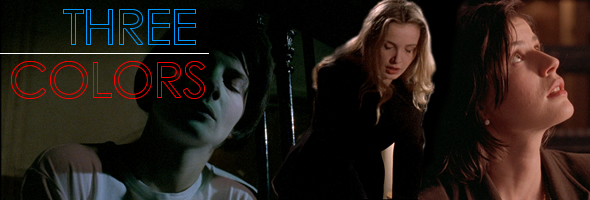
THREE COLORS: BLUE
Color, 1993, 98m.
Directed by Krzysztof Kieslowski
Starring Juliette Binoche, Benoît Régent, Florence Pernel, Charlotte Véry
THREE COLORS: WHITE
Color, 1994, 91m.
Directed by Krzysztof Kieslowski
Starring Zbigniew Zamachowski, Julie Delpy, Janusz Gajos, Jerzy Stuhr
THREE COLORS: RED
Color, 1994, 99m.
Directed by Krzysztof Kieslowski
Starring Irène Jacob, Jean-Louis Trintignant, Frédérique Feder, Jean-Pierre Lorit
Criterion (Blu-Ray & DVD) (US RA/R1 HD/NTSC), M2K (Blu-Ray & DVD) (France RB/R2 HD/PAL) / WS (1.85:1) (16:9) / DD2.0
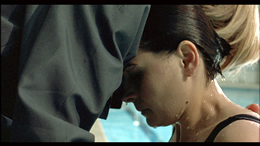 While Miramax ruled the art film scene in America throughout the '90s with a string of notable successes, perhaps its greatest contribution was the perfectly handled release of Krzysztof Kieslowski's remarkable Three Colors trilogy over a one-year period. Already a long-established director in Poland, Kieslowski had recently scored his first major critical hit in English-speaking territories with the elliptical The Double Life of Veronique, which charts the parallel lives of two identical women in France and Poland with a surprising twist. That approach leaps forward exponentially over the course of this trio of films, which manage to both stand alone as satisfying cinematic achivements and work together to form a whole even more satisfying when viewed in succession.
While Miramax ruled the art film scene in America throughout the '90s with a string of notable successes, perhaps its greatest contribution was the perfectly handled release of Krzysztof Kieslowski's remarkable Three Colors trilogy over a one-year period. Already a long-established director in Poland, Kieslowski had recently scored his first major critical hit in English-speaking territories with the elliptical The Double Life of Veronique, which charts the parallel lives of two identical women in France and Poland with a surprising twist. That approach leaps forward exponentially over the course of this trio of films, which manage to both stand alone as satisfying cinematic achivements and work together to form a whole even more satisfying when viewed in succession.
The first and most wrenching film, Three Colors: Blue, marked a career high for actress Juliette Binoche, previously seen in The Unbearable Lightness of Being, Damage, and one of Miramax's most notorious orphan films, the mad and majestic Lovers on the Bridge. Here she plays Julie, a woman traumatized by the deaths of her husband and child in a car wreck. Her famous composer spouse seems to cast a long shadow over her life as she goes through rehabilitation and isolates herself, often physically in long swimming pool sessions. Gradually we learn through implication about her real relationship with her husband and his work, and the power of music and one of their mutual colleagues (Régent) pushes her back into connecting with the world even in the face of jarring revelations about her husband's past. The plot itself is subservient here to the intense visual scheme of the film, which uses the title color and delicate lighting to convey its character's inner emotional and creative state; equally important is the powerhouse score by Zbigniew Preisner, one of the decade's most important film composers, whose work here could easily rank with the best modern classical music.
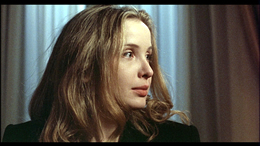 Audiences had to wait a few months to see the second film and were often surprised to encounter Three Colors: White, a much lighter and quirkier look at fate and nationality about a Polish immigrant in Paris, Karol Karol (The Decalogue's Zamachowski), whose marriage disintegrates in spectacular fashion in divorce court by his hostile wife, Dominique (Delpy). Stuck playing a comb in the Paris metro, he's offered an unusual opportunity to return to his homeland in his suitcase -- and a bizarre chain of events leads to violence, a murder charge, and a most peculiar form of redemption. Unlike the other two films, this one has a distant and very ambiguous relationship with its gorgeous lead actress; the French-born Delpy (previously seen in Europa Europa and still to reach America with a string of Richard Linklater films) still manages to make an intoxicating impression, however, and the peculiar, sometimes Hitchcockian mechanics of the storyline make this a strangely haunting breather between the more expansive bookending films.
Audiences had to wait a few months to see the second film and were often surprised to encounter Three Colors: White, a much lighter and quirkier look at fate and nationality about a Polish immigrant in Paris, Karol Karol (The Decalogue's Zamachowski), whose marriage disintegrates in spectacular fashion in divorce court by his hostile wife, Dominique (Delpy). Stuck playing a comb in the Paris metro, he's offered an unusual opportunity to return to his homeland in his suitcase -- and a bizarre chain of events leads to violence, a murder charge, and a most peculiar form of redemption. Unlike the other two films, this one has a distant and very ambiguous relationship with its gorgeous lead actress; the French-born Delpy (previously seen in Europa Europa and still to reach America with a string of Richard Linklater films) still manages to make an intoxicating impression, however, and the peculiar, sometimes Hitchcockian mechanics of the storyline make this a strangely haunting breather between the more expansive bookending films.
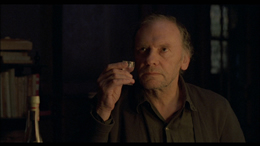 And that brings us to Three Colors: Red, the culmination of the trilogy and one of the pivotal international films from the past two decades. The Double Life of Veronique's Jacob returns in even finer form here as Valentine, a fashion model in Switzerland who accidentally runs over a German Shepherd. She tracks down its owner, a retired judge (The Conformist's Trintignant), who fills his lonely life with audio surveillance on his neighbors. Meanwhile a young law student named Auguste (Lorit) keeps narrowly missing encounters with Valentine and seems to be her star-crossed soulmate, but only with a startling turn of events will all three lives come together with the larger fabric of the other films and the unpredictable, fate-driven nature of humanity at large.
And that brings us to Three Colors: Red, the culmination of the trilogy and one of the pivotal international films from the past two decades. The Double Life of Veronique's Jacob returns in even finer form here as Valentine, a fashion model in Switzerland who accidentally runs over a German Shepherd. She tracks down its owner, a retired judge (The Conformist's Trintignant), who fills his lonely life with audio surveillance on his neighbors. Meanwhile a young law student named Auguste (Lorit) keeps narrowly missing encounters with Valentine and seems to be her star-crossed soulmate, but only with a startling turn of events will all three lives come together with the larger fabric of the other films and the unpredictable, fate-driven nature of humanity at large.
Thanks to a much-publicized snag in submission rules, Three Colors: Red became one of the highest profile films disqualified for a Best Foreign Film nomination at the Academy Awards; however, it went on to become a watershed film thanks to its bold visual style (not surprisingly, the color red has seldom been used more indelibly) and the seductive, Ravel-inspired Preisner score. Trintigant also has one of his best late-period roles here, and viewers can have fun on repeated viewings catching all the little motifs carried from one film to the next which reach their payoff here. (Keep an eye on that old lady!) 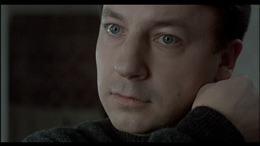
The DVD releases of all three films around the world were generally a very disappointing bunch, with gritty-looking transfers that only hinted at the delicate cinematic textures seen in theaters. To make matters worse, Blue suffered from inadequate subtitles in almost every incarnation which ditched the translation of the Greek chorus from the finale which was initially fully translated in theatrical prints. (This oversight was only surpassed when a key song from La Vie en Rose was inexplicably left unsubtitled in the translation to home video around the world years later.) Fortunately the Criterion edition corrects all of these oversights and then some, with the Blu-Ray set in particular featuring pin-sharp transfers that accurately reflect the appearance of the theatrical prints. The often ethereal lighting and powerful color schemes look terrific throughout, and the lossless DTS-MA two-channel stereo soundtracks do justice to the marvelous soundtracks.
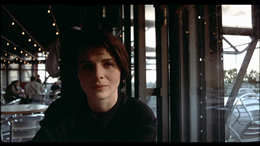 Extras are plentiful for each film, with Blue kicking off with a 20-minute video essay by film professor Annette Insdorf and an archival 7-minute Kieslowski film lesson walking through one scene from the film; significantly, Preisner also gets a 21-minute video chat for what is arguably his most important film and discusses the fictitious classical composer who plays a role in several of his collaborations with the director. Binoche also appears for a selected scene commentary (comprising a little under a third of the film) in which she talks about the emotional demands of her role and the tricks she used to convey a complex inner life, while the 17-minute "Reflections on Blue" featurette from the DVD release is ported over. Also included is the mini-interview show "Kieslowski: The Early Years," which features several collaborators and admirers (including Agnieszka Holland) discussing his pre-Miramax period. Finally the disc wraps up with the trailer and two of his 1966 student shorts, "The Tram" and "The Face," both of which are very brief but worthwhile character sketches. White features another one-scene cinema lesson from the earlier DVD, a 21-minute video dissection of the film by critic Tony Rayns, new interviews with both of the lead actors and co-writer Krzysztof Piesiewicz, the 16-minute making-of from the DVD, the trailer, and two early Kieslowski documentary shorts, "Seven Women of Different Ages" (1978) and "Talking Heads" (1980), which feature dance students and man on the street interviews respectively. Last up, the Red disc features the last one-scene cinema lesson with Kieslowski from the film, a new 22-minute overview by critic Dennis Lim, a very nice 16-minute chat with Jacob, separate interviews with producer Marin Karmitz and editor Jacques Witta, over 20 minutes of behind-the-scenes footage, an EPK-style look at the film's premiere at Cannes, the original trailer, and most substantial of all, the lengthy documentary "Krzysztof Kieslowski: I'm So-So..." from 1995, which runs nearly an hour and was previously released on video as a standalone feature by First Run. Whew! The set also includes the usual thick booklet containing essays by critics including Colin McCabe, Nick James, Stuart Klawans, and Georgina Evans, along with exceprts from the solid interview book Kieslowski on Kieslowski and interviews with three of his cinematographers.
Extras are plentiful for each film, with Blue kicking off with a 20-minute video essay by film professor Annette Insdorf and an archival 7-minute Kieslowski film lesson walking through one scene from the film; significantly, Preisner also gets a 21-minute video chat for what is arguably his most important film and discusses the fictitious classical composer who plays a role in several of his collaborations with the director. Binoche also appears for a selected scene commentary (comprising a little under a third of the film) in which she talks about the emotional demands of her role and the tricks she used to convey a complex inner life, while the 17-minute "Reflections on Blue" featurette from the DVD release is ported over. Also included is the mini-interview show "Kieslowski: The Early Years," which features several collaborators and admirers (including Agnieszka Holland) discussing his pre-Miramax period. Finally the disc wraps up with the trailer and two of his 1966 student shorts, "The Tram" and "The Face," both of which are very brief but worthwhile character sketches. White features another one-scene cinema lesson from the earlier DVD, a 21-minute video dissection of the film by critic Tony Rayns, new interviews with both of the lead actors and co-writer Krzysztof Piesiewicz, the 16-minute making-of from the DVD, the trailer, and two early Kieslowski documentary shorts, "Seven Women of Different Ages" (1978) and "Talking Heads" (1980), which feature dance students and man on the street interviews respectively. Last up, the Red disc features the last one-scene cinema lesson with Kieslowski from the film, a new 22-minute overview by critic Dennis Lim, a very nice 16-minute chat with Jacob, separate interviews with producer Marin Karmitz and editor Jacques Witta, over 20 minutes of behind-the-scenes footage, an EPK-style look at the film's premiere at Cannes, the original trailer, and most substantial of all, the lengthy documentary "Krzysztof Kieslowski: I'm So-So..." from 1995, which runs nearly an hour and was previously released on video as a standalone feature by First Run. Whew! The set also includes the usual thick booklet containing essays by critics including Colin McCabe, Nick James, Stuart Klawans, and Georgina Evans, along with exceprts from the solid interview book Kieslowski on Kieslowski and interviews with three of his cinematographers.






